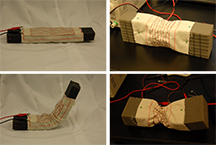
Orienting the robotic fabric in two different directions causes a block of foam to either bend or compress, a principle that could be used to create robots that inch forward or slither. (Credit:-Purdue University/Rebecca Kramer)
Researchers are developing a robotic fabric that moves and contracts and is embedded with sensors, an approach that could bring “active clothing” and a new class of “soft” robots.
Such an elastic technology could make possible robots that have sensory skin, stretchable robotic garments that people might wear for added strength and endurance, “g-suits” for pilots or astronauts to counteract the effects of acceleration, and lightweight, versatile robots to roam alien landscapes during space missions.
The robotic fabric is a cotton material containing sensors made of a flexible polymer and threadlike strands of a shape-memory alloy that return to a coiled shape when heated, causing the fabric to move.
“We have integrated both actuation and sensing, whereas most robotic fabrics currently in development feature only sensing or other electronic components that utilize conductive thread,” said Rebecca Kramer, an assistant professor of mechanical engineering at Purdue University. “We also use standard sewing techniques to introduce the thread-like actuators and sensors into the fabric, so they could conceivably be integrated into the existing textile manufacturing infrastructure.”
The robotic fabric can be wrapped around a block of foam or an inflated balloon. Orienting the fabric in one direction causes the robot to bend, producing locomotion like an inchworm’s. Orienting the fabric in a different direction causes it to compress – producing a peristaltic – or slithering locomotion.
Findings are detailed in a research paper presented during the International Conference on Intelligent Robots and Systems on Sept. 14–18 in Chicago. The paper was authored by doctoral students Michelle Yuen, Arun Cherian, Jennifer Case and Justin Seipel; and Kramer.
The work is related to research she is leading through a NASA Early Career Faculty award, announced in July, focusing on “active elastic skins for soft robotics.” The skin will contain a shape-memory alloy for muscle-like movement as well as numerous sensors to provide feedback and environmental information.
The goal is to make possible a class of soft robots where all the functional elements are embedded in a stretchable skin. This skin will include flexible electronics that are less sensitive to vibration than conventional hardware, making them rugged enough for space missions. Such a technology could allow space travelers to ship lightweight, easy-to-store sheets of robotic skin for assembly once they reach their destination.
Like the robotic fabric, the skin might be wrapped around a deformable object, creating robots capable of exploring alien terrains.
“We will be able to design robots on the fly,” Kramer said. “Anything can be a robot because all of the robotic technology is in the fabric or skin.”
In a related paper during the conference, researchers demonstrated a “variable stiffness” fabric that could be used as a medical brace and for other robotic applications. That paper was authored by graduate student Thomas Chenal, a visiting scholar from Ecole Polytechnique Federale de Lausanne in Switzerland (EPFL); Purdue doctoral student Jennifer Case; EPFL researcher Jamie Paik; and Kramer.
Fibers of a shape-memory polymer allow the fabric to have changing stiffness. The polymer goes through a “phase transition” when heated, causing it to become soft. Such a fabric could be used in medical braces that lock in place for support. The polymer is coated with a shape-memory alloy that heats up when electrical current is applied, causing it to soften.
The approach represents a potential energy-efficient technology for robotics.
“Ordinarily, if we are moving a hinge joint and want to maintain a particular position, we would have to maintain a high energy input to keep the joint from relaxing,” Kramer said. “Here, we could just lock it in place.”
Source: Purdue University.
Published on 29th September 2014


